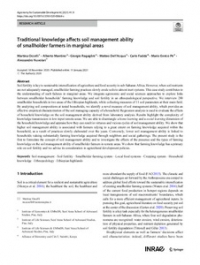Proposing alternatives to intensify farming and improve land use and ecosystems services at landscape level in rainfed systems demand for robust methods and tools. In this activity we proposed developing and fine-tuning state of the art approaches, in cross collaboration with sister Centers, ARIs and related CRPs. The first cluster of activities deal with the need of having reliable geospatial information on daily rainfall for modeling water balance, including the characterization and modeling of shallow ground water level dynamics, river recharge, etc. This is an on-going activity with CIAT-Africa in the Volta River basin. Several of the tools being tested for large-scale reconstruction of rainfall were developed by CIP with CCAFS, using mechanical statistical approaches. The second cluster deals with enhancing the efficiency in the use of water by crops. CIP has been testing the partial root-zone drying in potato under different environmental conditions and using different irrigation schemes at small-scale (Reported and published under WLE). In 2015 & 2016 we expect to introduce the technology in the Blue Nile Basin (Ethiopia) and unravel some crucial physiological mechanisms to fine tune the technique as well as testing the method at commercial scale. We are also evaluating the use of minor water stress periods as priming to enhance WUE. The third cluster deals with soil carbon stocks and quality. CIP and EMBRAPA initiated this work in the Andes and East Africa (Reported and published under WLE) and using novel portable or semi-portable laser-based equipment such as Laser Induced Breakdown Spectroscopy (LIBS) and Laser Induced Fluorescence (LIF). Previous work has been published under WLE and is closely related to the work conducted by CIP. The soil and water department from University of Florida is a partner in this research. A PhD student is working on modeling soil carbon dynamics. A limiting factor in modeling soil-carbon-nutrients-water relations across scales is the lack of good quality data at the resolutions needed. The research proposed focuses on generating and processing remotely sensed information to be used as ancillary data. To assess the robustness of the procedures tested, the theory will be developed in data-rich environments to ascertain the biases introduced as data scarcity increases. We propose using non-linear processes to characterize and model these soil-nutrients-water relations. Tools and methods will be programmed in open source software and national partners in developing countries will be trained in their use, once validated. This work has attracted the attention of policy-makers and with a small grant from CCAFS we will be complementing the research to support Peruvian Ministries of Agriculture and the Environment to generate the first agricultural NAMA in Peru. This is a great opportunity to show synergies between these two CRPs. Tools developed by CIP and partners must be anchored in the larger pathway developed by the Program to generate the expected impact. Therefore, a senior Applied Physicist has been posted to Nairobi to jointly implement the applications with ICRAF, CIAT, and other WLE partners.
menu










